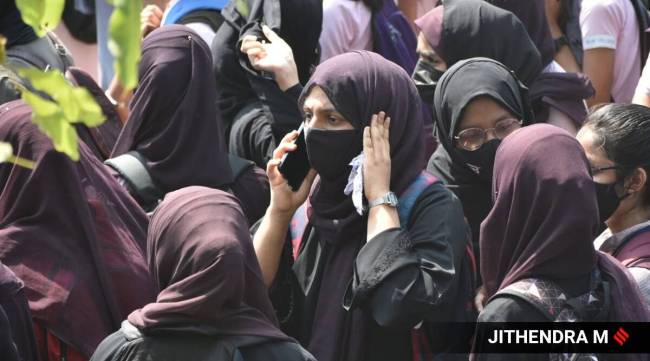Opinion What the hijab debate gets wrong, why wearing hijab isn’t a choice
Most young women who wear the garment have it imposed in childhood. Any clothing that covers a woman's face is regressive.
 The argument in support of the hijab proceeds on a deeply flawed assumption that girls have an option to wear or not wear it. (Express photo)
The argument in support of the hijab proceeds on a deeply flawed assumption that girls have an option to wear or not wear it. (Express photo) Written by Sunil Fernandes
Shahrukh Alam’s article, ‘Personal liberty, public space’ (IE, October 15) seeks to support the right of schoolgirls to wear their hijab in coastal Karnataka, essentially on the ground of freedom of choice, which is a part of the Fundamental Rights guaranteed by the Constitution. But is the right to wear hijab actually a matter of free choice?
The argument in support of the hijab proceeds on a deeply flawed assumption that girls have an option to wear or not wear it. And since they have exercised their free agency and chosen to wear the hijab, the laws of the land must respect their choice. This argument fails to recognise the fact that the families that prescribe and subscribe to the hijab usually make it mandatory for their female children, when they are as young as four or five years old, to wear the garment whenever they step outside their home or when they are in presence of male family members. The choice of wearing or not wearing the hijab is already made for them by the accident of their birth. The collective pressure exerted by families, especially the male members, a deeply conservative society, and the burden of arcane interpretations of religious dogma make it virtually impossible for any of the hijab-clad girls to exercise free choice.
Did the pro-hijab lobby test their hypothesis of free choice by inquiring from the concerned girl students as to what age did they actually commence wearing the hijab? Were they given the option to discard the hijab when they reached the age of discretion and when it was time for them to enter pre-university college? The fact that families in coastal Karnataka chose that the girl students lose an academic year rather than give up their hijab for a short while inside the school premises is clearly indicative of the choice or lack of it, that these girls have. Those parents who chose to imperil their daughters’ studies by placing their educational pursuits subservient to a hijab deserve to be called out in unambiguous terms. Instead, we witness sophistry being employed to defend the indefensible.
These girls will receive the benefit of the “freedom of choice” argument only till they choose to wear the hijab. I wonder if they will garner similar passionate support if, tomorrow, they decide to stop wearing the hijab. What if, as adults, they decide to marry a non-Muslim? What if they declare their support to the LGBTQIA community? What if some of them identify themselves with the LGBTQIA community in terms of their sexual preference? Would we still witness articles and arguments in support of these girls?
My staunch opposition is to any kind of apparel that seeks to impose the covering of a girl/woman’s face like the hijab, naqab, burkha, purdah, ghoonghat, etc. under any purported religious compulsion — not merely Islam, but other faiths well. Such practices are regressive and misogynistic and should have no place in a progressive 21st-century society.
Alam seeks to insinuate that Mahsa Amini’s assault by the Iranian moral police has more to do with her Kurdish roots than her improperly worn hijab. She buttresses this by giving examples of two evening strolls that she had in Sri Lanka, one with an ethnic Tamil and the other with a Sinhalese, with diametrically opposite reactions from the patrol police. It’s unfortunate that rather than a clear unambiguous condemnation of the actions of the Iranian moral police, the article equivocates and presents us with an unacceptable excuse of her Kurdish origins. Hundreds of Iranian girls have risen in rebellion against the brutality of the Iranian moral police towards Mahsa Amini and have paid the ultimate price.
The writer is an Advocate-on-Record, practising in the Supreme Court of India. Views are personal



